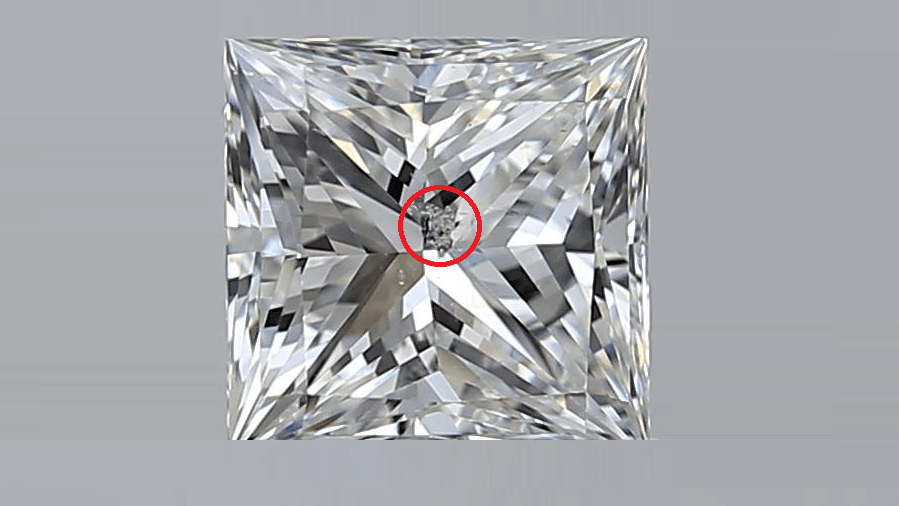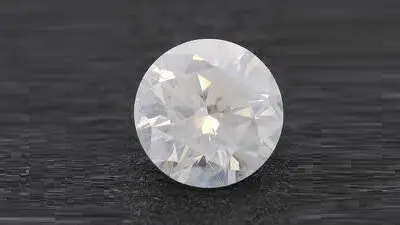Shocking Truth About Diamond Internal Graining

By Gary A.

Edited by Olivia H.
Published Mar 26, 2022
Edited on Mar 31, 2025
When evaluating the clarity of a diamond, diamond internal graining is one characteristic that often goes unnoticed but can subtly impact the overall beauty of the stone.

- 5 Quick Tips for Examining Diamond Internal Graining When Buying an Engagement Ring
- Introduction
- The Science Behind Diamond Graining
- Recognizing Internal Graining
- Using Your Diamond’s Report to Understand Graining
- Graining and Diamond Value
- Our Expert Take
- 10 FAQs
Before we dive deeper into the specifics, here are some practical tips to help guide your decision-making process:
5 Quick Tips for Examining Diamond Internal Graining When Buying an Engagement Ring
- Tip 1: Understanding the Impact of Internal Graining Know the Basics: Grasp the fundamental understanding that internal graining is a natural characteristic of diamonds, often resulting from growth irregularities. It’s essential to recognize that some level of internal graining is common and doesn’t always detract from the diamond’s beauty. Learn to Identify: Familiarize yourself with how internal graining appears. It may manifest as lines, curves, or patterns within the diamond. While not always visible to the naked eye, knowing what to look for under magnification can help you make an informed choice.
- Tip 2: Evaluating the Visibility of Graining Check Under Magnification: Use a jeweler’s loupe or microscope to examine the diamond. Look for any signs of internal graining. If diamond graining is present, note its intensity and whether it’s visible without magnification. Assess the Aesthetic Impact: Determine if the graining affects the overall appearance of the diamond. Graining that’s noticeable to the naked eye, especially if it clouds the diamond, can impact its brilliance and value.
- Tip 2 : Balancing Graining with Other 4Cs Compare with Clarity Grade: Remember that internal graining is a factor in determining the clarity grade of a diamond. A diamond with minimal graining might still have a high clarity grade. Compare the graining with the official clarity grade to understand its impact better. Consider Cut and Color: A well-cut diamond can sometimes offset the visual impact of internal graining. Similarly, the color of a diamond can interact with graining, either making it more noticeable or less so.
- Tip 3: Graining vs. Other Inclusions Distinguish Graining from Other Inclusions: Learn the differences between graining and other types of inclusions like clouds, pinpoints, or crystals. This knowledge will help you make a more educated decision about the quality and value of the diamond.
- Tip 4: Making a Value-Based Decision Evaluate the Price Impact: Understand how internal graining affects the diamond’s price. Diamonds with minor, invisible graining often offer better value compared to flawless ones. Consider if paying extra for a diamond with less or no visible graining aligns with your budget and value expectations.
- Tip 5: Assessing Long-Term Effects Consider Durability and Longevity: While internal graining typically doesn’t affect a diamond’s structural integrity, heavy graining could pose potential risks in specific cases. Assess the long-term durability of the diamond, especially if it will be worn daily.
Now that you’ve got these practical tips, use Jeweler AI below to find the perfect engagement ring that suits your style and budget:
Introduction
This is why it’s totally understandable that so many diamonds come to the surface of the earth with slight imperfections – inclusions buried deep within their internal structure, trapped beneath the diamond’s surface many, many thousands of years in the past.
There are a lot of different types of inclusions. Some are caused by chemical impurities – traces of other substances locked into the diamond’s tight structure – while others are faults within the structure itself.
Internal graining is the perfect example of this – a flaw with the diamond’s own structure, rather than an impurity or crystal caught inside the diamond. It’s pretty common to see it printed on GIA reports, so here’s what you need to know about it.
The Science Behind Diamond Graining
It takes more than a billion years for a diamond to form – for that unique, fascinating crystal structure to begin to form and to grow into the rough stones that are cut and polished into true works of art.
As a result of the incredible pressure it takes for them to form, diamonds are the product of a tight atomic structure. Each carbon atom is bonded to four other carbon atoms, creating the rigid, strong, hard, and characteristically transparent substance famed across the globe. All this was completed over an unimaginably long stretch of time, and deep below the earth’s surface, where only the most brutal forces of nature are at work.
How Graining Occurs During Diamond Formation
Instances of abnormal crystal development is the internal graining diamond meaning. They do look a little like polish marks, but caught inside the diamond, rather than lying on its surface.
Put simply, graining is a flaw in that internal structure. It can be the result of slowed or accelerated growth. Think of how the rings in a tree stump indicate their fluctuating growth – times when the weather was on their side, and times when they almost stopped growing. It’s a similar story for diamonds. So when thinking about the question ‘What is internal graining in a diamond’, know that is natural and common.
Recognizing Internal Graining
Internal graining isn’t usually all that obvious and is often disguised very well within smaller diamonds, meaning plenty of diamonds with internal graining are still eye clean. This inclusion can be visible from some angles, and not from others – for instance, you might find a diamond where internal graining is visible under magnification from the pavilion, but not through the table.
The Difference Between Internal and External Diamond Grading
External graining is caused by polish marks since diamond cutters have to use very strong tools to get the diamond-shaped and polished to a high standard. Most diamonds on the market won’t feature polish marks, but it does take skill and experience to avoid causing that damage.
The main difference is this: diamond internal graining is natural, and external graining is man-made. External graining can be fixed with a repolish, but internal graining cannot be removed without cutting away parts of the diamond – the internal graining diamond means that it is beyond the reach of the polisher’s wheel.
Understanding the Impact of Graining on Diamond Clarity
Graining will be reflected in a diamond’s Clarity grade. It may not be a visible feature when you’re looking at the diamond with your naked eye, but that’s not to say it won’t be noticed by the graders.
It may be significant enough that the diamond receives an SI or I grade. On the other hand, in a diamond with a clarity grade of VVS1 internal graining will be very minor.
Either way, eye cleanliness is what matters.

Using Your Diamond’s Report to Understand Graining
If you can’t see it for yourself, then look in the GIA report. Any noteworthy instances of diamond graining will be explicitly mentioned in the report.
Internal graining is rarely identified on a diamond plot, since it is often so minor (particularly in comparison with other types of inclusions) and hard to spot even under 10x magnification.
In diamonds graded high on the clarity scale – say, VVS1 and VVS2 diamonds – it’s not uncommon for the ‘Additional Grading Information’ to contain the following phrase:
- Clarity grade is based on internal graining that is not shown.
This means that your diamond’s internal graining is incredibly minor and that it won’t be detectable without strong magnification.
Of course, while this is reassuring to read, it’s not the best way to pick out a diamond. The best options are eye clean, but at a much lower clarity grade, since VVS1 and VVS2 diamonds are priced thousands of dollars higher simply because they’re one step closer to ‘perfect’.
It’s way better to go for, say, an eye clean VS2 diamond with a few inclusions illustrated on the diamond plot than a VVS2 diamond with nothing more than a little internal graining.
Graining and Diamond Value
Anything pertaining to diamond clarity will have a direct impact on the diamond’s value. How much depends on the extent of the graining. As we mentioned, a diamond with internal graining could feasibly achieve a VS1 or VS2 grade, which would entail a price tag right at the higher end of whatever carat size you’re looking at.
If the diamond has a VS or SI grade, then it’ll hit that sweet spot between quality and affordability. If it’s graded as an I1 or I2 diamond, then it’s going to be a lot more affordable, but offer a lot less value for money.
Graining vs. other inclusions: What to prioritize?
Look for major inclusions that are visible to the naked eye, or non-visible inclusions that are located dangerously close to the diamond’s surface (particularly any vulnerable points, like corners or the culet). Diamond surface graining will be much more obvious – and important to avoid.
While diamond internal graining is (almost always) relatively minor, there are some inclusions that you just can’t take the risk on – even if the diamond itself appears eye clean. Some faults can (and will) threaten a diamond’s structural integrity and, while a good jeweler will always be there to stop you from making any mistakes, it’s always worth knowing what to look out for, rather than hoping you don’t make a bad purchase.
Our Expert Take
Remember that the internal graining diamond meaning is a flaw on the inside of the diamond, so in extreme cases, internal graining can cause a diamond to appear cloudy and dull. This is, of course, a lot less common than instances of minor, non-visible internal graining, but it’s worth knowing that it can be a lot worse.
In these cases, you will be able to see straight away that the diamond is being impacted significantly by its own inclusions.
But, if the diamond appears eye clean (and the diamond graining is not dangerously close to the surface) then don’t be deterred by the GIA report. All that matters is the structural integrity and strength of the diamond, and how it looks to the naked eye.
Winding up with a lifeless diamond is one of the biggest risks you run when you shop at these stores. At WillYou.com, our experts hand-check diamonds, passing the gems through our 11-step process to ensure we sell only the highest quality.
10 FAQs
- Q: What is Diamond Graining?
- A: Diamond graining refers to natural lines or patterns inside a diamond, caused by irregularities during its formation.
- Q: How Does Graining Affect a Diamond’s Appearance?
- A: Graining can impact a diamond’s clarity, sometimes causing haziness or visible lines, especially if the graining is extensive.
- Q: Is Internal Graining Common in Diamonds?
- A: Yes, internal graining is a common feature in diamonds, often occurring naturally during the diamond’s growth process.
- Q: Can Graining Decrease a Diamond’s Value?
- A: Significant graining – whether that’s surface graining diamond or internal graining – can reduce a diamond’s value as it might affect the clarity and overall appearance.
- Q: Should I Avoid Diamonds with Graining?
- A: Not necessarily. Minor graining that doesn’t impact the diamond’s clarity or brilliance can be acceptable.
- Q: Can You Remove Graining from a Diamond?
- A: Graining is an inherent part of a diamond’s structure and cannot be removed without altering the diamond itself.
- Q: How Can I Identify Graining in a Diamond?
- A: Graining can be identified under magnification, typically with a jeweler’s loupe, and is often noted in the diamond’s grading report.
- Q: Does Surface Graining Diamond Differ from Internal Graining?
- A: Yes, surface graining diamond occurs on or near the diamond’s surface, while internal graining is found within the diamond’s internal structure.
- Q: Are There Different Types of Graining?
- A: Graining can vary in type and severity, including reflective and colored internal graining – yes, colored internal graining diamond – each affecting the diamond differently.
- Q: Does Graining Affect All Diamond Shapes Equally?
- A: Graining can affect different shapes in varying degrees, but its visibility largely depends on the diamond’s overall cut and clarity.
Discover the ideal diamond free of graining flaws with Jeweler AI. Let our advanced AI guide you to the perfect, pure engagement ring choice.
FOLLOW-UP GUIDE SERIES





















